The Intel Broadwell Review Part 2: Overclocking, IPC and Generational Analysis
by Ian Cutress on August 3, 2015 8:00 AM ESTGenerational Tests: Office and Web Benchmarks
For this review, as mentioned on the front page, we retested some of the older CPUs under our new methodology. We did this testing at stock frequency as well as the IPC testing to see the ultimate real world result when you add in HyperThreading and frequency into the mix. If you recall back in our Devil’s Canyon i7-4790K review, the new high 4.4 GHz frequency of the i7-4790K was a tough one to beat for the newer architecture purely because any IPC gains are nullified by the older processor having a lot more frequency. With the Broadwell based i7-5775C being at 3.7 GHz and only 65W, this is a tough task. But what about if you are still running the Sandy Bridge based i7-2600K?
Some users will notice that in our benchmark database Bench, we keep data on the CPUs we’ve tested back over a decade and the benchmarks we were running back then. For a few of these benchmarks, such as Cinebench R10, we do actually run these on the new CPUs as well, although for the sake of brevity and relevance we tend not to put this data in the review. Well here are a few of those numbers too.

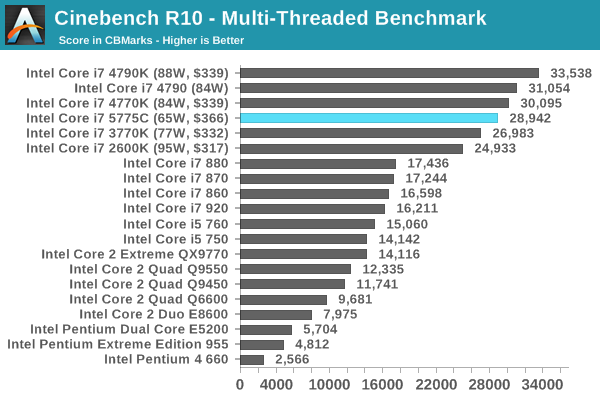
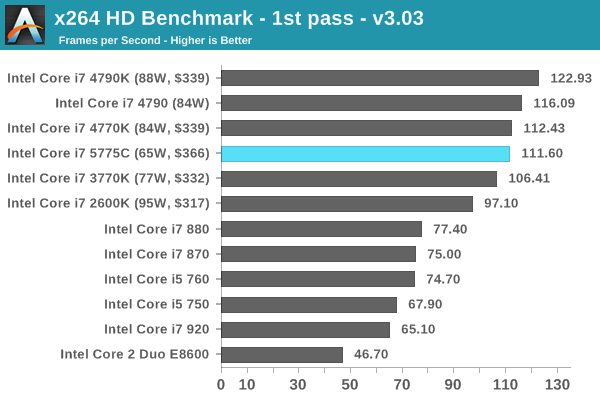
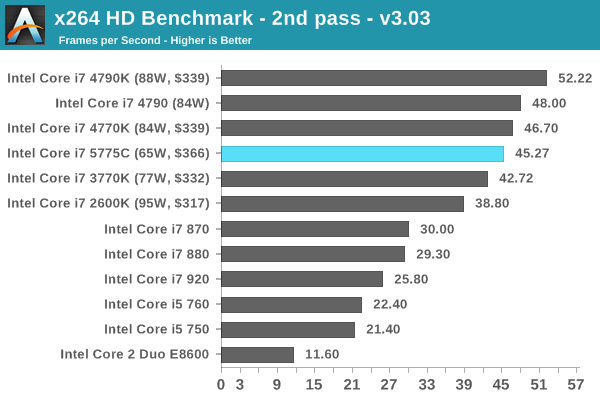
With some of these benchmarks, due to applications using new instruction sets, having the newer processors with the new instructions can make a lot of difference. Even in Cinebench R10, moving from the Core 2 Quad Q9550 to a Broadwell can get a 2.5x speed-up in this old software.
For the rest of our CPU benchmarks, here is what the landscape looks like with the most recent architectures. All of our benchmark results can also be found in our benchmark engine, Bench.
Office Performance
The dynamics of CPU Turbo modes, both Intel and AMD, can cause concern during environments with a variable threaded workload. There is also an added issue of the motherboard remaining consistent, depending on how the motherboard manufacturer wants to add in their own boosting technologies over the ones that Intel would prefer they used. In order to remain consistent, we implement an OS-level unique high performance mode on all the CPUs we test which should override any motherboard manufacturer performance mode.
Dolphin Benchmark: link
Many emulators are often bound by single thread CPU performance, and general reports tended to suggest that Haswell provided a significant boost to emulator performance. This benchmark runs a Wii program that raytraces a complex 3D scene inside the Dolphin Wii emulator. Performance on this benchmark is a good proxy of the speed of Dolphin CPU emulation, which is an intensive single core task using most aspects of a CPU. Results are given in minutes, where the Wii itself scores 17.53 minutes.
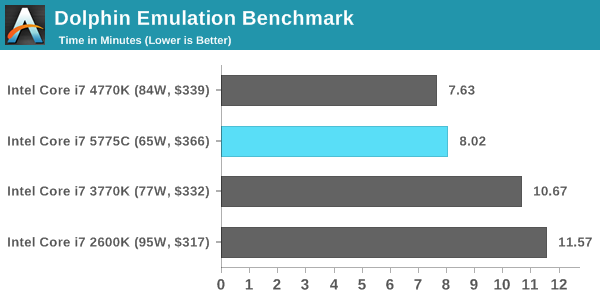
WinRAR 5.0.1: link
Our WinRAR test from 2013 is updated to the latest version of WinRAR at the start of 2014. We compress a set of 2867 files across 320 folders totaling 1.52 GB in size – 95% of these files are small typical website files, and the rest (90% of the size) are small 30 second 720p videos.

3D Particle Movement
3DPM is a self-penned benchmark, taking basic 3D movement algorithms used in Brownian Motion simulations and testing them for speed. High floating point performance, MHz and IPC wins in the single thread version, whereas the multithread version has to handle the threads and loves more cores.
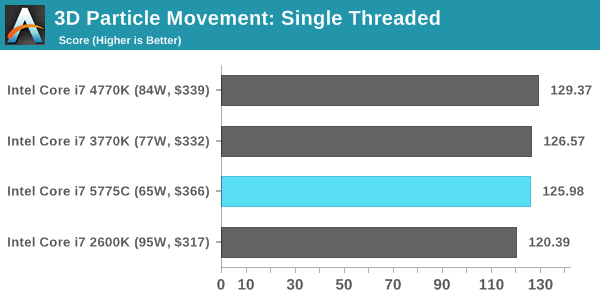

FastStone Image Viewer 4.9
FastStone is the program I use to perform quick or bulk actions on images, such as resizing, adjusting for color and cropping. In our test we take a series of 170 images in various sizes and formats and convert them all into 640x480 .gif files, maintaining the aspect ratio. FastStone does not use multithreading for this test, and results are given in seconds.
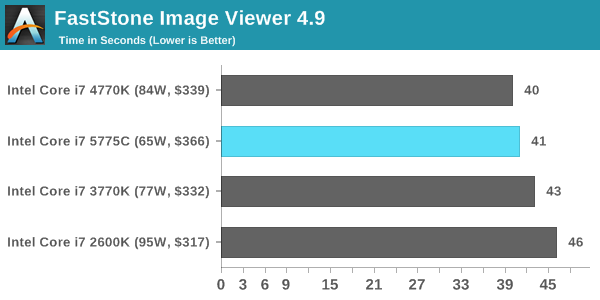
Web Benchmarks
On the lower end processors, general usability is a big factor of experience, especially as we move into the HTML5 era of web browsing. For our web benchmarks, we take four well known tests with Chrome 35 as a consistent browser.
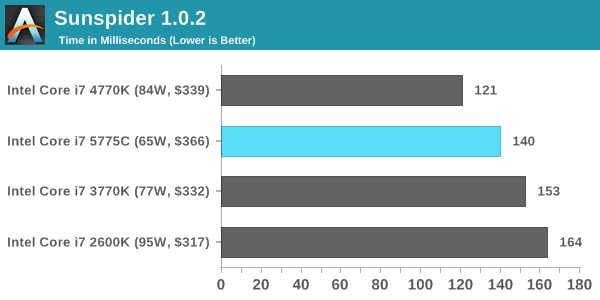
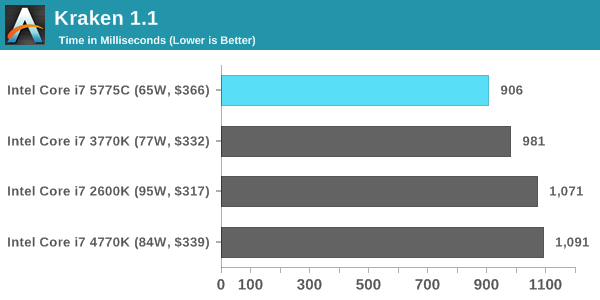
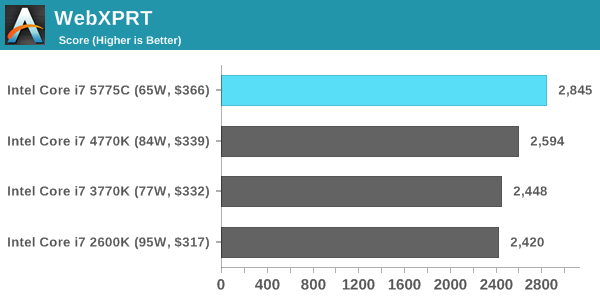











121 Comments
View All Comments
TheinsanegamerN - Monday, August 3, 2015 - link
Quite nice comparison.Unfortunately, it seems that, while broadwell does have the best IPC of the bunch, the overclock is pathetic. 1.325v to hit 4.2 GHz? my ivy bridge 3570k does the same clock with 1.075v. now, I've been told I have a exceptionally good chip, but it strikes me as odd that broadwell, being on a smaller 14nm process, cant match what ivy bridge could do two years ago. and since sandy bridge can be OC'ed to 4.7GHz+ with ease,and ive can hit 4.5, it seems there is still no reason to upgrade to broadwell, as any IPC gains are cancelled out by the lower clock rate. unless you need to do lots of dolphin emulation and refuse to overclock at all, the ancient sandy bridge still seems to do the best.
K_Space - Monday, August 3, 2015 - link
TheinsanegamerN agreed. Those who held into their Sandy made a very wise investment, just like those good ol' 920s back in the X58 era.Dupl3xxx - Monday, August 3, 2015 - link
Ah, yes, the 920 was a lovely beast. Started overclocking at 3.6. It booted, tried 3.8, booted, tried 4.0, failed. 3.8 was literally done in less than an hour as my second ever attempt at overclocking, with my first being the intel e6600. And when a dying PSU wounded it, I got a 3930k. It does 4.0 ghz, and I've yet to find any situation where it's a bottleneck, besides things like rendering and benchmarks. I considered upgrading to the 59xx series, but when I learned that only the 5960x would be a 8-core, that was quickly decided against.It'll be interesting to watch Skylake and Zen fight it out in a year or so.
Impulses - Monday, August 3, 2015 - link
I'm surprised Intel isn't banking on nostalgic memories of the Q6600 to hype the 6600K & 6700K... Surely marketing had a hand in the simplified naming reminiscent of the old C2Q.augiem - Monday, August 3, 2015 - link
I'm still on a i7-920 from mid 2009. Been running 3.6GHz the entire time, still rock solid as the day I bought it. I still can't believe I've been using a PC for this long. Before the i7, I would upgrade every 1.5 - 2 years tops. This thing is nuts.mkozakewich - Tuesday, August 4, 2015 - link
We've reached the end of that exponential advancement, so you can expect things to advance at roughly this rate for a while, at least until we also reach "small enough".close - Tuesday, August 4, 2015 - link
That's logarithmic advancement :). It keeps slowing down year after year.Cryio - Tuesday, August 4, 2015 - link
Technically with Sandy Bridge they reached the end. SB was quite a jump over Nehalem.Harry Lloyd - Tuesday, August 4, 2015 - link
There is no end. Intel just do not care, as they have no competition. Why would they waste money on increasing performance, when they can focus on efficiency for mobile? They can get away with selling basically the same CPUs every year on desktop, as they are still the fastest.Badelhas - Tuesday, August 4, 2015 - link
I also blame AMD. If they had good high end CPUs Intel would be forced to improve the ones they´ve been selling for the last 5 years or so.